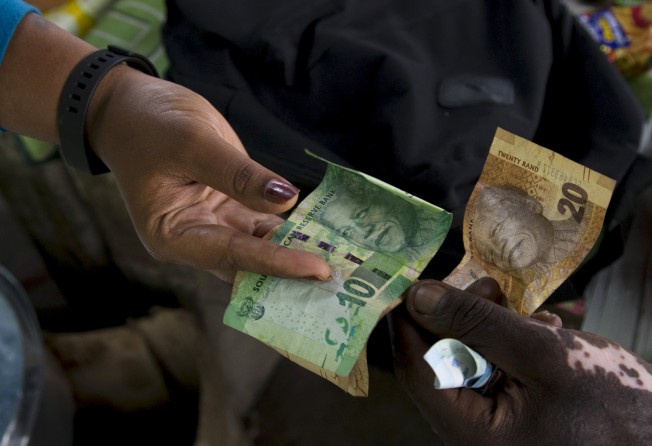Rand gives real a run for its money as most vulnerable emerging market currency
At one point on Monday, South Africa’s currency plummeted 9 per cent against the greenback in a ‘flash crash’

These are painful times for financial investors.
The sharp China-driven deterioration in market sentiment has resulted in the worst start to a year since the mid-1990s, with more than US$4 trillion wiped off the value of global equity markets last week.
Emerging market (EM) currencies have, together with the ailing commodity markets, borne the brunt of the declines in asset prices. The Russian rouble has dropped a further 4.8 per cent against the US dollar since the start of this year, while the Turkish lira and the Malaysian ringgit have fallen an additional 3.4 per cent and 1.8 per cent respectively.
Yet the EM currency that sticks out like a sore thumb in terms of its vulnerability to deteriorating market conditions is the South African rand.
Since January 4, the first trading day of the year, the rand has lost nearly 7 per cent against the US dollar. At one point on Monday it plummeted 9 per cent in what traders call a “flash crash” – a sharp and short-lived swing in the securities prices stemming from a dearth of liquidity in financial markets.
In a sign of the extent to which the rand has become more vulnerable of late, its decline since mid-October has made the Brazilian real – which for most of last year was the most unloved EM currency – look like a relatively stable currency. While the real has lost a further 3 per cent against the greenback, the rand has plummeted 28 per cent.
While Brazil remains one of the riskiest EMs, with an economy in even worse shape than South Africa’s – Brazil’s inflation rate, fiscal fundamentals and gross domestic product numbers are significantly worse – South Africa is suffering from the same toxic combination of domestic weaknesses and external vulnerabilities that caused the real to plunge nearly 50 per cent against the US dollar last year.
The trigger for the sharper decline in the rand was the highly unexpected decision on December 9 by South Africa’s president, Jacob Zuma, to fire the country’s respected finance minister, Nhlanhla Nene, severely undermining the credibility of South Africa’s policy regime at a time when credit rating agencies were mulling downgrading the sovereign.
Although strong domestic criticism of Zuma’s move eventually forced the president to reappoint the well-regarded Pravin Gordhan as finance minister on December 13, the damage had been done. JP Morgan rightly notes that “a perception shift has occurred which will not be easily reversed”, adding that it does not believe “a change of identity at the finance ministry is sufficient to give the all-clear to buy the rand”.
Indeed no sooner did the rand stabilise than another bout of turmoil in China’s equity and currency markets put renewed strain on the currency, which is extremely sensitive to developments in China given the South African economy’s heavy dependence on commodities, with metals and minerals accounting for over a third of export earnings.
As is the case in Brazil, where a debilitating political crisis stemming mainly from a high-profile corruption scandal at Petrobras (the state-run oil company) and the economic damage wrought by the plunge in commodity prices have pulled the rug out from under the country’s financial markets, South Africa is suffering from a double whammy of country-specific and China-driven problems.
The former is the more troubling of the two – particularly given the China- and oil-price-driven volatility in financial markets. On Tuesday, US and European equity markets rose slightly, while on Wednesday EM stocks began to recover due to better-than-expected data on Chinese exports and a slight recovery in oil prices.
Yet South Africa’s woes, just like Brazil’s, are mostly homegrown.
When Moody’s, the rating agency, lowered its outlook on South Africa’s credit rating on December 15, it drew attention to “increasing political pressures” which are undermining the prospects for much-needed fiscal and structural reforms at a time when growth has collapsed.
Indeed this is the predicament faced by a number of developing economies, including other members of the so-called BRICS group of EMs, notably Russia and China.
The politics of economic reform in EMs is becoming a major concern for investors, mainly because country-specific risks have become more important determinants of sentiment towards developing economies over the past few years.
Movements in the rand and the real are influenced as much, if not more, by domestic developments as they are by external ones.
China and oil prices matter – but so do Zuma’s actions, which is why the rand is now the most vulnerable EM currency.
Nicholas Spiro is managing director of Spiro Sovereign Strategy